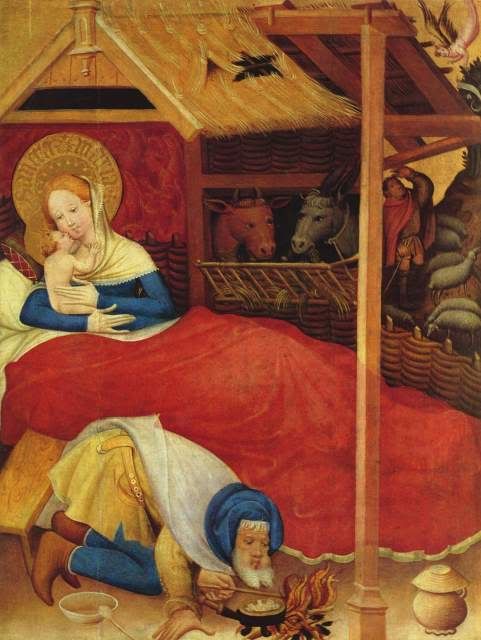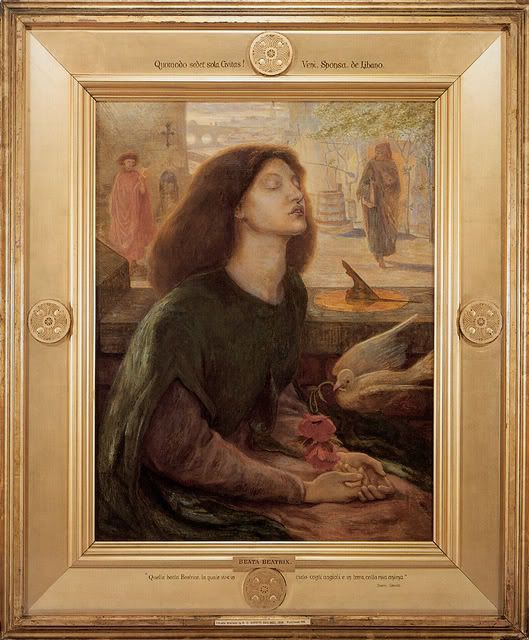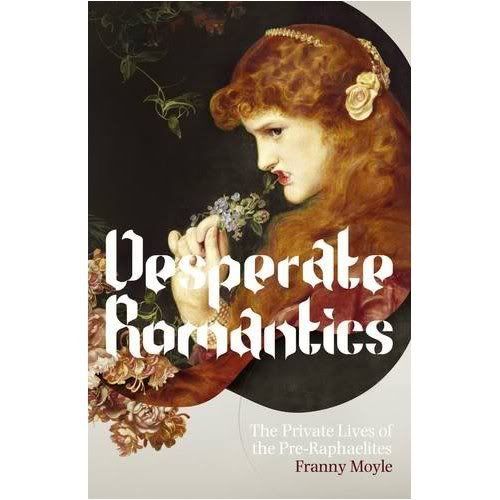
Here's a truly "Pre-Raphaelite" painting for you all! This Nativity scene was painted by Conrad von Soest in 1403. Von Soest, who was born in 1370 in Dortmund, was considered one of the greatest artists in Westphalia. He introduced the "International Courtly Style" of art to Northern Germany, and influenced Northern European art throughout the 15th century.
This image captured my eye because of its domesticity! For one thing, it was the first time I'd seen a nativity scene that featured Joseph cooking for his new family! Mary and Jesus look so tender as well (get a closer look at the expressions on their faces, and you'll know what I mean!).
Perhaps it's because this is my first Christmas with a little baby of my own, but this year I wanted to see rather more familial tenderness and a bit less distanced adoration among the Holy Family. No doubt Charles Dickens (who considered Milais' "Christ in the House of His Parents" sacrilegious for its frank portrayal of Christ's family) wouldn't have been very impressed with von Soest's more familial portrayal of the Nativity scene, but I'm sure the Pre-Raphaelites would have loved it!
On a side note, I find the ahistorical touches, such as the medieval clothing and any number of details in the painting, rather charming. Besides, I sometimes wonder if medieval artists were just trying to make historical paintings approachable for their audience. Perhaps by giving historical figures contemporary clothing and accoutrements, von Soest was ensuring that his audience would spend less time wondering why Mary and Joseph were wearing funny clothes! (what modern child didn't grow up asking their parents why Joseph ran around in a skirt and sandals all the time - I know I did!).
Happy Holidays to all, and much prosperity and happiness in the New Year!
Image courtesy of Wikipedia.
Thursday, December 24, 2009
Happy Holidays!
Posted by
Margaret
at
10:51 AM
3
comments
![]()
![]()
Thursday, December 10, 2009
Blue Italian made in England once again

Some of you will recall that I was devastated when Spode went bankrupt last year. Blue Italian was my wedding china pattern. I fell in love with the design the first time I saw it, and I started collecting it for my hope chest when I was about 12 years old (yes, I'm a little old fashioned, if you haven't gathered that from this blog so far!). I still remember asking for Blue Italian pieces every year for Christmas and for my birthday!
Spode was a multi-generational thing in my family. My dad's mom collected blue and white china, and had a beautiful set that I used to look at for hours in our china cabinet back at home. My mother was also in love with blue and white. I remember treasuring every one of Victoria Magazine's "Blue and White" issues - I felt like they had been especially designed for me! Now that I have a little girl of my own, I can't help but hope that she shares my love for the colour combination.
Over the past several months, I had given up on Spode - especially after receiving a shipment of horrible quality Blue Italian that had been manufactured in China. Fortunately, one Earthly Paradise reader--James, from Staffordshire--stayed on top of the story. He had originally commented on my post "The End of an Era--Spode Begins Overseas Production" . Last Thursday, he left an update on the company that was so good that I've decided to reproduce it here in its entirety. Thanks to huge disappointment with the quality of the made-in-China Blue Italian, Portmeirion is once again manufacturing Blue Italian in Staffordshire!
Even more months on now, and over a year since Spode called in the administrators.
A lot of people will know this by now. The trade names and intellectual property rights of Royal Worcester and Spode were purchased by the Portmeirion Group of Stoke-on-Trent in April 2009. The historic Church Street site, alas, was not part of the deal. Ceramics will never be made there again, ending a 240 year old era during which the finest wares in the world were produced.
Spode lost it's Royal Warrant, held since 1806, upon ceasing trading. Spode produced the china for the Titanic, the Queen Mary, British and European aristocracy, and of course, the British Royal Family.
The Spode museum and archives, a separate entity from the business, was moved to Stoke-on-Trent City Museum.
Now for a bit of good news. Go to www.spode.co.uk and you will see that Portmeirion has started making "Italian" again in Stoke-on-Trent! "Stafford Flowers" has also just been re-introduced. "Woodland" and "Christmas Tree" are also in production; the latter in China, unfortunately. But Portmeirion (one of the few genuine success stories in the tableware industry) is committed to bringing back production to Staffordshire, partly in response to the huge backlash against cheap imports from Asia.
For me, however, as a Spode collector of 30 years, things will never be the same again. Spode which comes from anywhere other than that wonderful site on Church Street in Stoke-on-Trent just isn't Spode. It was my favourite place on Earth, and I still haven't got over the events of the last 12 months.
Oh, I forgot to add that most of the Church Street site contains buildings which are "listed" by English Heritage (a government agency). What this means is they are of exceptional architectural and historical significance, and cannot be demolished.
The 9.5 acre site is also part of a conservation area designated by Stoke-on-Trent city council.
The council is, in fact, in the process of raising funding to purchase the entire site for about 5 million pounds (around 8 million US dollars) so they can control exactly what goes on there in the future. I think there is talk of a ceramics museum combined with other small scale retail, residential and recreational land use. The important thing is that much of the site will remain the same, because the buildings are protected.
Hope this is useful info for you all. James.
Thanks so much for your message, James! This is fabulous news, though I'm still in mourning for Spode.
Posted by
Margaret
at
5:35 PM
5
comments
![]()
![]()
Labels: news
“Apostles of Beauty: Arts and Crafts from Britain to Chicago”

“Apostles of Beauty: Arts and Crafts from Britain to Chicago” is a new exhibit at the Art Institute of Chicago celebrating the Arts and Crafts movement. For those of you who would love to see Dante Gabriel Rossetti's "Beata Beatrix" in the flesh, this is your chance, as it's one of the pieces featured in the exhibit!
"Apostles of Beauty" features 187 "handcrafted, organic works by the movement's most notable practitioners." The pieces in the show are drawn from a variety of artistic disciplines, including ceramics, wood and metalwork, paintings, photographs and textiles.
In its overview of the exhibit, the museum's website calls the Arts and Crafts movement "one of the most politically progressive and aesthetically compelling artistic movements of modern times." It planted the seeds for the sort of critical thinking about modern living that has driven the green movement. Arts and Crafts connected organic thinking and living on a large scale for the first time, and demonstrated that the "beautiful and useful" as William Morris loved to say, were not mutually exclusive. As the museum's website so beautifully puts it:
The Arts and Crafts movement sprang from a rebellion against industrial life and mass-produced objects yet eventually united hand and machine in the service of beauty.
On a side note, it certainly seems like 2009 has been a great year for interest in Arts and Crafts and the Pre-Raphaelites. It would be interesting to know if there are actually more exhibits being held, or if it just seems like there are because I'm always looking for them! (I suppose I could find out if I had the time or discipline to research the issue). Could it be a bit of both?
"Apostles of Beauty" runs now through January 31, 2010.
Read more at The Art Instutute of Chicago's website.
Posted by
Margaret
at
1:53 PM
2
comments
![]()
![]()
Labels: art nouveau, arts and crafts, museums, news, rossetti, william morris
Saturday, December 5, 2009
'Desperate Romantics' Makes Telegraph's List of Art History Books of the Year

It's been a great year for the Pre-Raphaelites! Franny Moyle's book, "Desperate Romantics", which inspired the television series of the same name, was named in the UK Telegraph's list of Art History Books of the Year.
There are a number of books on the list that will be of interest to Art History lovers. For the full list, click here.
Posted by
Margaret
at
2:51 PM
1 comments
![]()
![]()
Labels: books, news, pre-raphaelites

